Deliciously thin and delicate crepes filled with cherry tomatoes, fresh spinach, eggs and mozzarella: these are the perfect breakfast buckwheat galettes.

Despite that perfectly oozy yolk and perfectly crisp crepe, these galettes are actually really easy to make from start to finish in a single pan. Plus they're suitable for vegetarians and naturally gluten free!
The batter is a simple combination of buckwheat flour, water and a pinch of salt. The batter is rested overnight to develop the natural flavours of the flour and you'll be amazed how good it tastes.
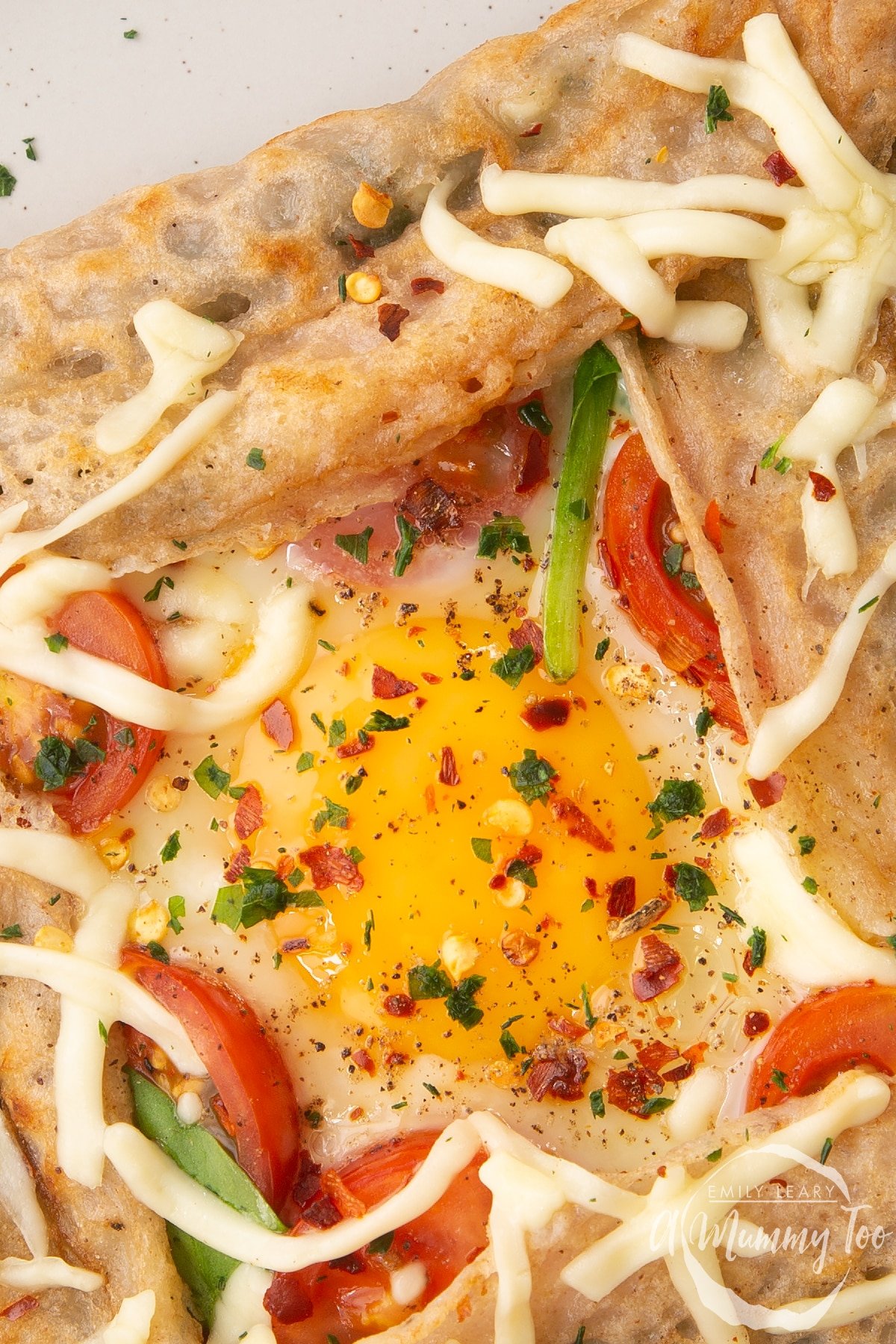
Once the crepe begins to cook in the pan, you'll start piling in the delicious fillings - the cheese, the cherry tomatoes, the spinach - and then you'll crack an egg into the centre and let everything cook together perfectly.
To finish, you'll simply fold the galette into that classic square parcel and scatter with chilli flakes and a touch more grated cheese.

The result is utterly deliciously. Sweet tomatoes, earthy spinach, gooey cheese, custardy egg, all wrapped up in a gorgeously golden galette.
Here's how to make 8 buckwheat galettes.
Ingredients
For the galette batter
- 250 g (8.8 oz) buckwheat flour
- pinch salt
- 500 ml (1.1 pint) water
To fry
- 2 tbsp salted butter
To fill
- 500 g (1.1 lb) grated/shredded mozzarella
- 200 g (7.1 oz) fresh cherry tomatoes halved
- 50 g (1.8 oz) fresh spinach
- 8 medium free-range eggs
- 1 tbsp chilli flakes
- Pinch salt and black pepper
To garnish
- 5 g (0.2 oz) parsley finely chopped
Enough filling for 8 galettes - you may have spare batter, depending on the size of your pan. See the tips section for ideas on what to do with it.
Instructions
Put the flour and salt in a bowl.

Whisk together, then pour in 250ml water.

Mix into a thick paste, cover and refrigerate overnight to allow the flavours to develop.

When you're ready to make your galettes, add 250ml water.

Gently mix until you have a batter the consistency of double cream

Warm a little butter in a large frying pan over a medium heat.

When the pan has come up to heat, ladle in a small amount of batter and tip the pan to evenly distribute a thin layer of batter. (Note: the water can separate from the flour a little if the batter is left to sit, so gently stir the batter before each ladleful of galette.)

As soon as the batter has set, scatter on a small handful cheese.

Add a few cherry tomato halves.

Add a handful spinach, arranged in a circle - this will help contain your egg.
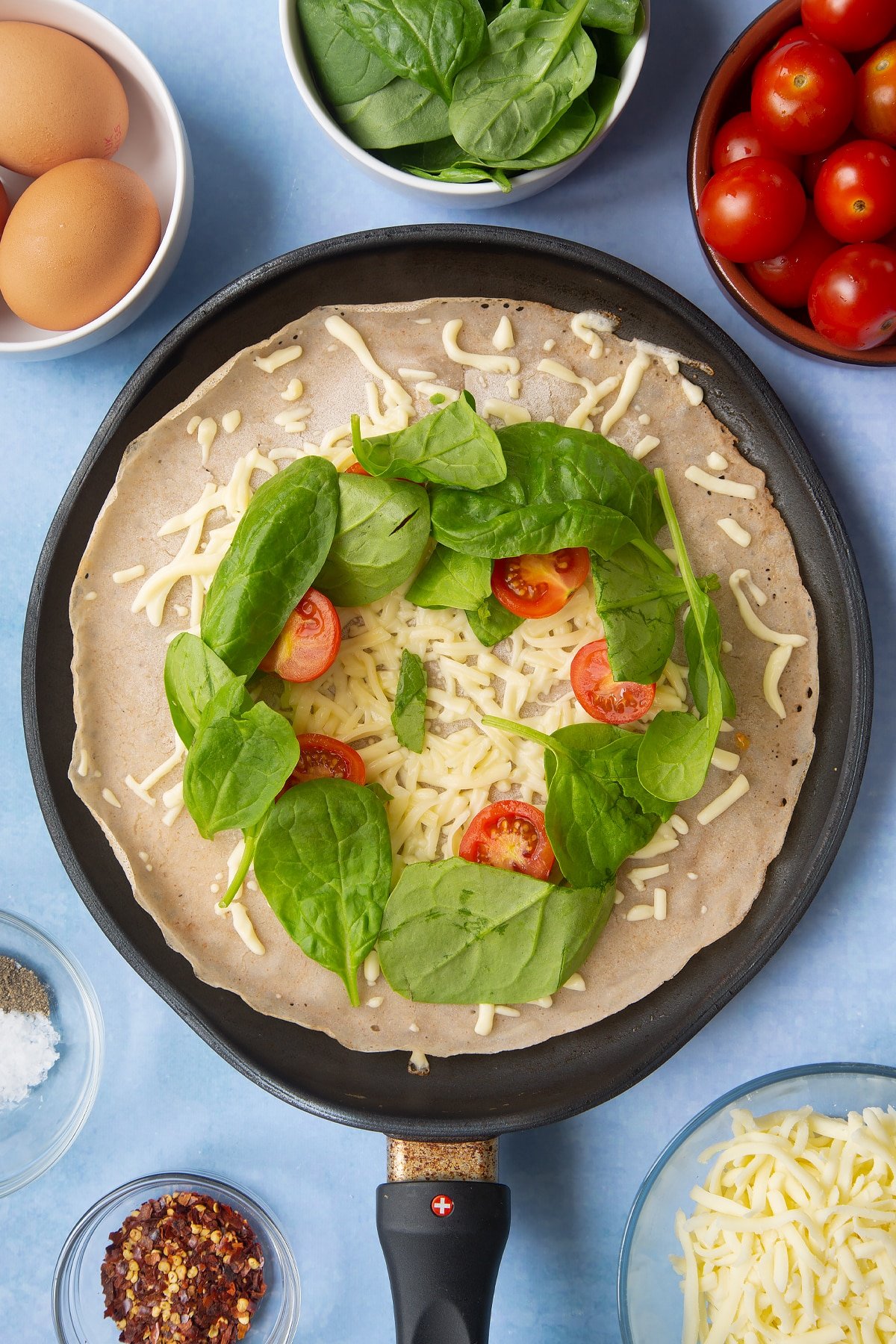
Crack an egg into the centre.

Allow the galette to cook until the underside is golden and mottled and the egg is almost set.

Use a spatula to fold the edges in towards the middle, to create a square with the yolk exposed in the centre.

Continue to cook until the egg white is set. Sprinkle with a pinch of chilli flakes, salt and pepper.

Scatter on a little extra cheese. It will melt from the heat of the galette.
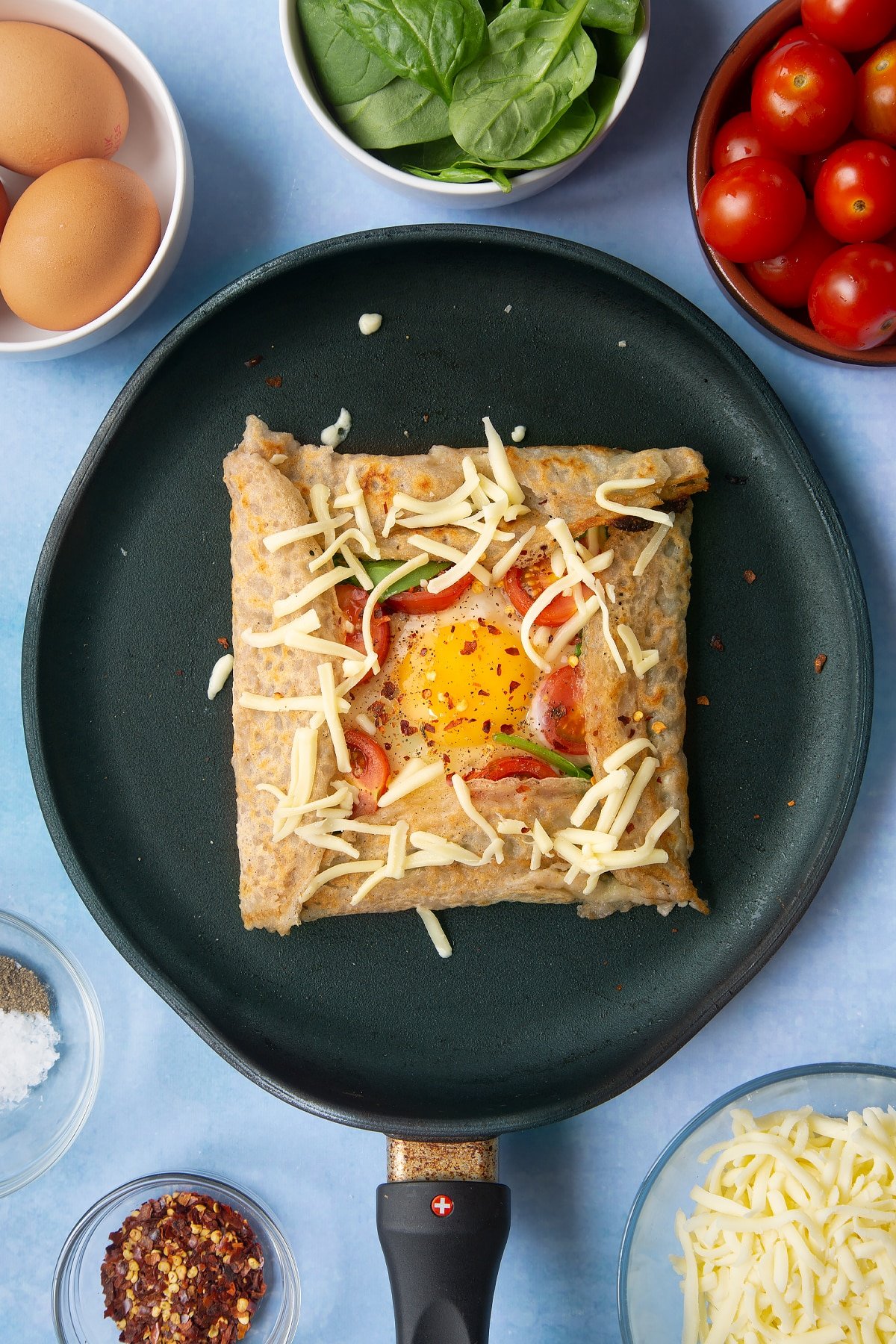
Use a spatula to transfer the galette to a plate. Scatter with a little parsley.

Repeat until all of your galettes are cooked.

The crepes can be kept warm on a nonstick baking sheet in a low oven if you’d prefer to serve them all at once.
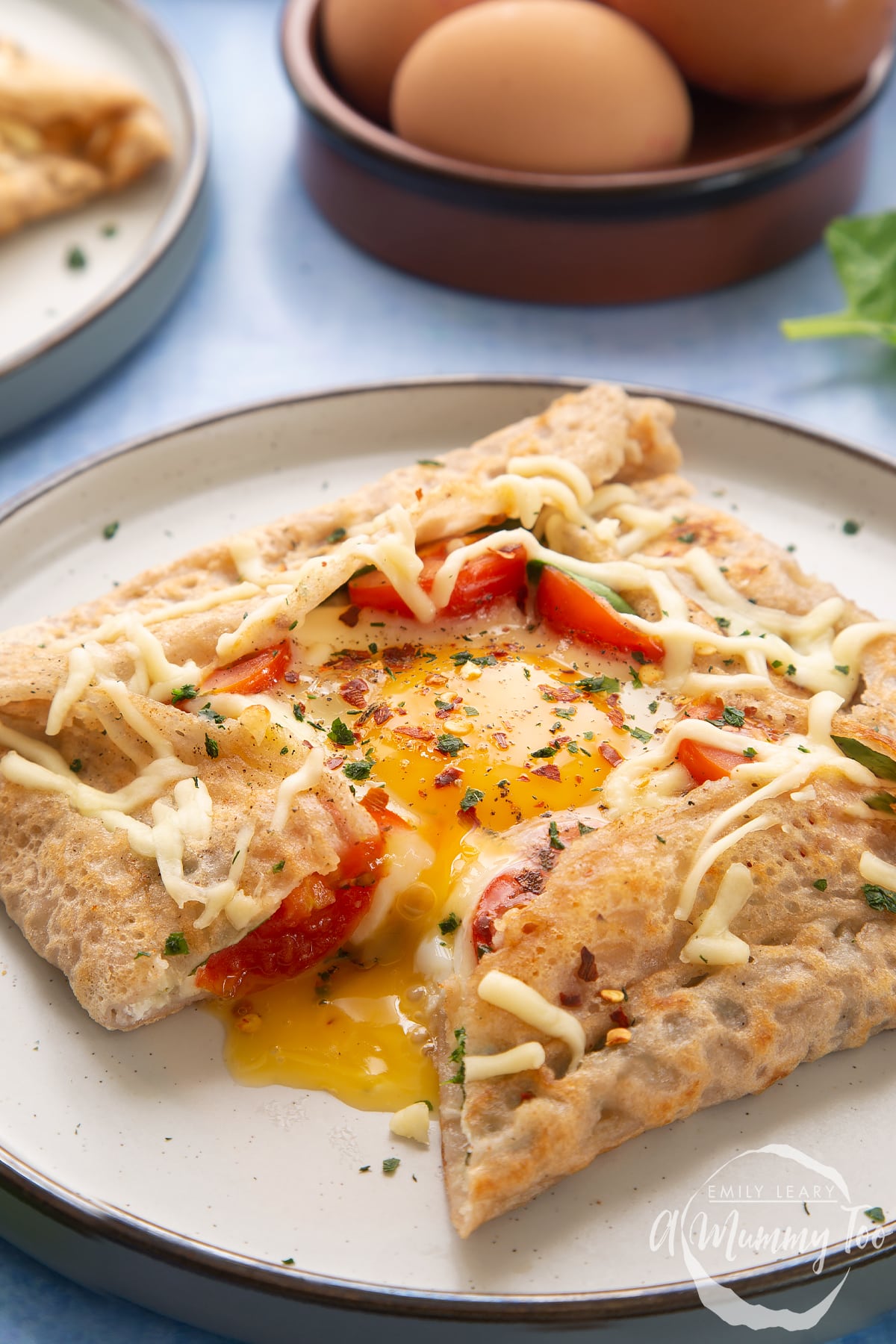
Enjoy!
Pointers, tricks and troubleshooting tips for the perfect buckwheat galettes
Are buckwheat galettes easy to make?
Yes, these buckwheat galettes are simple to make, just follow the steps in the recipe card below and you should get perfect galettes every time.
The main thing to be aware of is that your thick batter needs to rested overnight before having extra water whisked in the next morning, so you'll need to factor that in. I think this recipe is great for breakfast, so I make up the batter before bed on Saturday night and it's ready to cook up for a gorgeous Sunday morning treat.
For perfect results, I always recommend that you get your equipment out and prep all your fillings before you start to cook your galettes. That way, everything is to hand and ready to go as and when you need them.
This recipe is super flexible too, so you follow the recipe for buckwheat galette batter, then let your imagination run wild creating different filling combinations, savoury or sweet!
Will I need any special equipment for this recipe?
You should be able to find everything you need in the average kitchen: a large mixing bowl, whisk and weighing scales to make the batter, a large nonstick frying pan to cook the galettes in, and a chopping board, knife and grater to prep the fillings.
A full equipment list can be found in the recipe card below.
Where can I buy buckwheat flour?
Most large supermarkets will stock buckwheat flour in the baking section or you can always order it online.
Despite its wheaty name, buckwheat flour is naturally gluten-free. It doesn't come from a grass plant like regular wheat flour, but is in fact made using the seeds of a plant related to rhubarb and sorrel.
The seeds have similar carbohydrate properties to standard flour, so buckwheat flour is an excellent wheat flour replacement for anyone who needs to avoid gluten in their diet. It has a lovely, almost nutty, rich, wholemeal flavour, which I find brings more depth to recipes than plain white flour.
You can use buckwheat flour as part of the flour blend for soda bread, or make some gluten-free homemade pasta. Just be conscious that gluten free flour doesn't behave like wheat flour when it comes to recipes that would usually involve kneading to stretch the gluten.

Are buckwheat galettes suitable for vegetarians?
Yes! This recipe contains no meat, poultry or fish so is totally suitable for vegetarians.
Be mindful of the fillings you are using if you are catering for a mixture of meat-eaters and non meat-eaters.
Are buckwheat galettes suitable for vegans?
The crepes themselves are vegan as they are made solely with buckwheat flour, salt, and water, so are a great option for vegans.
However, the recipe features egg and dairy cheese in the filling, and the crepes are fried in butter, so you'd need to switch those out to make a vegan friendly version. How about some vegan butter, vegan cheese and then fried mushrooms or courgette in place of the egg?
Are buckwheat galettes gluten-free?
Yes! Buckwheat flour is made from a seed not related to the grasses that regular wheat flour is made from and does not contain gluten.
However, contamination can occur in production so if you are making this for someone who needs to avoid gluten in their diet always double-check the labels on every ingredient used.
Are buckwheat galettes keto-friendly?
Each galette in this recipe contains about 26g of carbohydrate so could be suitable for a keto diet depending on what else you are planning to eat that day.
Are buckwheat galettes healthy?
Each serving contains about 390 calories. These galettes are high in protein, but also quite high in fat so should be enjoyed as part of a balanced diet.
Obviously, if you start mixing up the fillings with chocolate spread and fruit for example, the nutritional content per serving would change.
Are buckwheat galettes safe to eat while pregnant?
Advice about egg safety during pregnancy differs from country to country depending on how the eggs are treated and handled, so please seek relevant information that is local to where you live.
In the UK, at the time of writing (Dec 2020), eggs with a Red Lion stamp are currently considered safe to eat runny, even when pregnant, though you may prefer to still thoroughly cook eggs. The NHS has loads of information on foods to avoid whilst pregnant.
Also make sure the cheese and butter you are using is made with pasteurised milk - most UK brands are, but it's wise to check.
This website does not offer medical advice. Please speak to your health professional if you have any concerns or questions.

Are buckwheat galettes suitable for babies and toddlers?
Once children are over 6 months old and happily eating solid food, these buckwheat galettes would be fine to feed toddlers.
There is a pinch of salt in the batter to help it develop, but you can leave this out for babies. Also make sure not to add any seasoning salt to the galettes being served to little ones. In the UK, if the eggs are not clearly marked with a Red Lion stamp make sure the white and yolk are fully cooked.
(Egg advice varies by country and changes overtimes, so please do not consider tips on a Mummy Too to be medical advice . Check the egg safety advise for your region)
Always give food at an appropriate size and shape for your baby or child. Half or quarter small fruits and veg like cherry tomatoes. And made sure the cheese you're using is made with pasteurised milk. It's not a good idea to give small children soft or mould-ripened cheeses.
Always keep young children supported upright while eating and supervise your baby when they’re eating in case they start to choke.
A whole galette will probablybe too much for a toddler, but perhaps siblings could share and have half each, or they do keep well in the fridge for a couple of days and are lovely for lunch too.
This website does not offer medical advice, please speak to your health professional if you have any questions. The NHS has some great information and guidance on foods to avoid giving to small children.
What goes well with buckwheat galettes?
With savoury galettes like these, a peppery rocket salad with a drizzle of balsamic glaze is great.
If you decide to go down a sweet route, about a dollop of yoghurt and a drizzle of honey?
Can I make this recipe without egg?
Yes, the batter for the crepes is naturally egg-free and you can easily use something else instead of egg for the filling. The fillings can be so flexible to your tastes and what's in the cupboard or fridge.
Personally, when we don't have eggs in the fridge, I love a bit of preserved artichoke with the tomato and spinach instead.
Are buckwheat galettes dairy free?
The batter for the buckwheat crepes is made simply with buckwheat flour, salt, and water, so to make these galettes dairy-free, all you need to is fry the crepes in oil or vegan spread instead of butter, and either leave out the cheese or use a plant-based cheese alternative.
Can I add extra veggies to this recipe?
There is only so much space in the galette so it's best to keep the toppings to two or three elements for each galette, but you can switch these around as much as you like. The main thing to bear in mind when choosing fillings in how long they take to cook. A thick layer of raw carrot or potato simply wouldn't cook in time with the crepe, for example.
Roasted veg and cheese is a winning combination, or you could forgo the savoury fillings and do fruit-filled galettes with fresh berries and banana.
How should I store buckwheat galettes? How long will they keep?
Once cooled, buckwheat galettes need to be transferred to the fridge within an hour of making. Depending on how many you have you could keep them on a large plate, or baking sheet, well covered.
Don't be tempted to stack them up in a container if they have egg in the middle as they will all stick together. If you've left out the eggs, once cool you might be able to stack them with a piece of baking paper between each one so they take up less space.
Filled buckwheat galettes will keep in the fridge for up to 2 days depending on the toppings you've used.
Any leftover batter can be made up into crepes, cooled, stacked between layers of baking paper, wrapped well and frozen. These will keep in the freezer for a couple of months.

Can I leave buckwheat galettes out on the counter?
No, these galettes contain egg and cheese and should not be kept out on the counter even if you've used different toppings. Make sure to get your left over galettes cooled, and into the fridge within an hour of cooking.
Can I make buckwheat galettes ahead?
You need to make the batter the night before so it can develop.
If you like, you could make up a whole batch of crepes in advance, cooling, stacking them between layers of baking paper, wrapping them well and then placing them in the fridge or freezer.
Bear in mind that in the recipe, the crepes are not fully cooked - the cooking process continues as the fillings are added, allowing everything to be ready at the same time. As such, you'll want to aim to only just cook your crepes so that they can finish cooking later.
Crepes will keep in the fridge for a couple of days or the freezer for a couple of months.
Can I freeze buckwheat galettes?
You can freeze the plain crepes ready to make up into filled galettes at a later date. They just need to be cooled, stacked between layers of baking paper, wrapped well and frozen.
Remember to only cook the crepes lightly so that they can finish cooking with the fillings when you come to make galettes.
Say you're a family of four, it's a good idea to freeze your crepes in sets of four so you that can more easily get out what you need. Crepes will keep in the freezer for a couple of months.
When you're ready to use them, thaw out overnight in the fridge or at ambient temperature for about an hour before warming, and cooking with your fillings in a lightly buttered frying pan as you would if making from scratch.
Once thawed, these buckwheat crepes need to be consumed within 24 hours and cannot be refrozen.
I wouldn't recommend trying to freeze filled galettes because the different fillings will not all freeze and reheat successfully.
What is the best way to reheat buckwheat galettes?
If you are reheating a few galettes its probably easiest to do so in the oven so that they will all be ready at the same time. Heat the oven to 180C (160C fan) and put the galettes in the oven on a lightly greased baking sheet for 8-12 minutes or until hot through. The yolks may not be runny after this process.
You can also reheat your galettes in a frying pan over a medium heat. Pop a little butter in the pan to stop them from sticking and heat for about 5 minutes. If you have a lid for your frying pan you can put this on to help them warm through evenly.
Can I make this recipe in a different quantity?
It's super simple to make more or fewer of these buckwheat galettes. I like to make the full amount of batter even if we don't make them all up into galettes at the time because the crepes freeze well and then you've done half the work for breakfast another time. (See my tips on freezing the crepes above).
To amend the quantities, simply scroll down to the recipe card below. You'll see the servings which are set to 8 as a base, all you need to do is click on this number and adjust the pop-up slider to get the number you want to make.
The ingredients will update automatically so you're ready to go.
Can I make this recipe in a stand mixer such as a KitchenAid or Kenwood Mixer?
As with pancake batter, you don't want to overwork this buckwheat crepe batter, so if you want to use a stand mixer, only do so on the lowest setting.
Put the buckwheat flour, salt,and water into the mixing bowl, and with the whisk attachment bring everything together into a thick paste. Leave the mix in the mixing bowl, cover well and refrigerate overnight.
When you're ready the next morning to make your galettes, add the remaining water and gently mix on low again until the batter is the consistency of double cream.
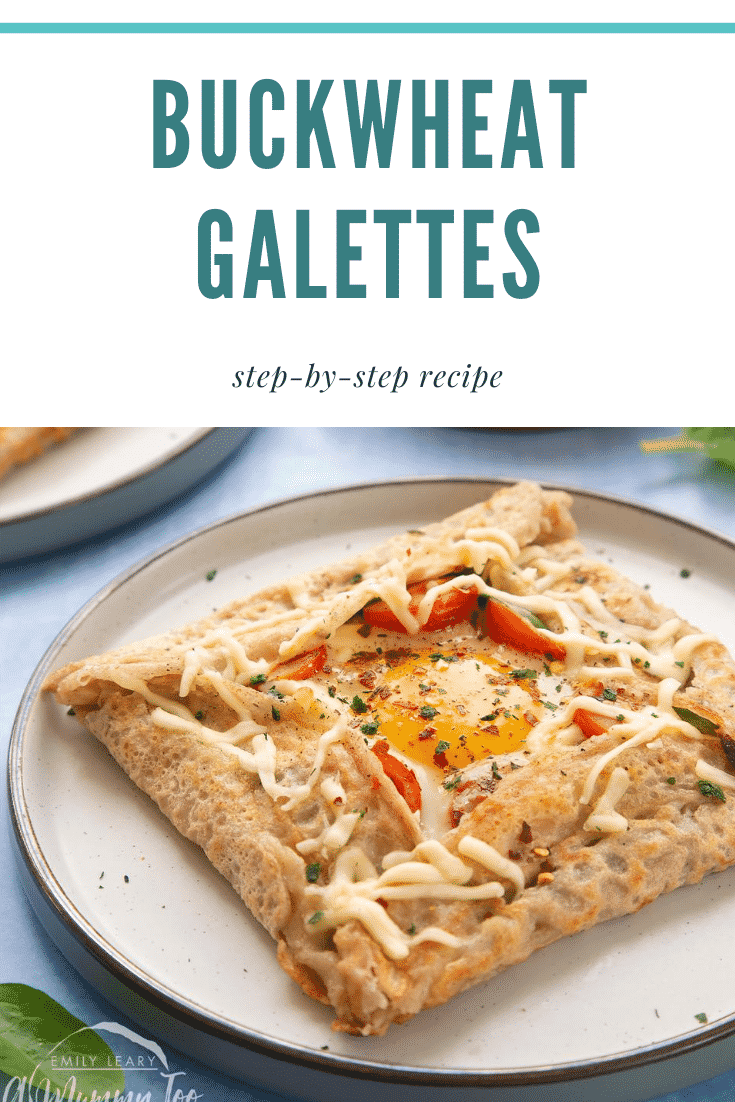
Why do I need to leave the batter in the fridge overnight?
This batter is made up of only buckwheat flour, salt, and water. Without the egg or milk often added to other crepe recipes, the mixture needs time to develop and turn into the required consistency. Otherwise, the batter won't bind together and turn into lovely crisp light crepes.
You could probably get away with leaving it for 4-5 hours if you're making these for lunch, but I prefer to leave it overnight to make sure the batter is successful.
When you come to cook your galettes, the batter may separate if its left on the side for a while so give it a gentle stir between each ladle going into the pan.
I only have one frying pan, how can we all eat as a family together?
When you start cooking your galettes, set the oven to 60C and get a few baking sheets ready.
Once you've folded in the edges of a galette, scatter with the cheese and chilli flakes and then take a large spatula, and immediately transfer it onto the baking sheet to finish cooking in the low oven.
You can keep adding galettes to the oven until they are all done. This method may mean some yolks are more set than others, depending on how long they've been in the oven.
How can I make sure my buckwheat galettes are perfectly cooked?
When the eggs are cooked in the middle and the galette base is lovely and crisp and a mottled pale browned, you'll know your galettes are ready.
It's important to heat the pan over a medium heat before you begin so that the batter sets quickly and evenly once added. And make sure the pan doesn't get too hot as you want everything to cook gently and evenly.
Once the galette is just set you can start to add the toppings, and when the egg is nearly done, gently check the underside of the galette by lifting the edge with a palette knife. It should be mottled and slightly browned. Fold in the edges to create a square around the filling and continue to cook as necessary until the egg is done (no clear egg white remaining).
Why did my galettes turn out burnt and stuck to the pan?
If you galettes burned, the pan was probably too hot, or the galette was left in too long. When you start off ,make sure to gently warm the frying pan over a medium heat.
Don't forget to add the butter as this will help stop the galette from sticking. You'll then need to add a little more butter to the pan between each galette.
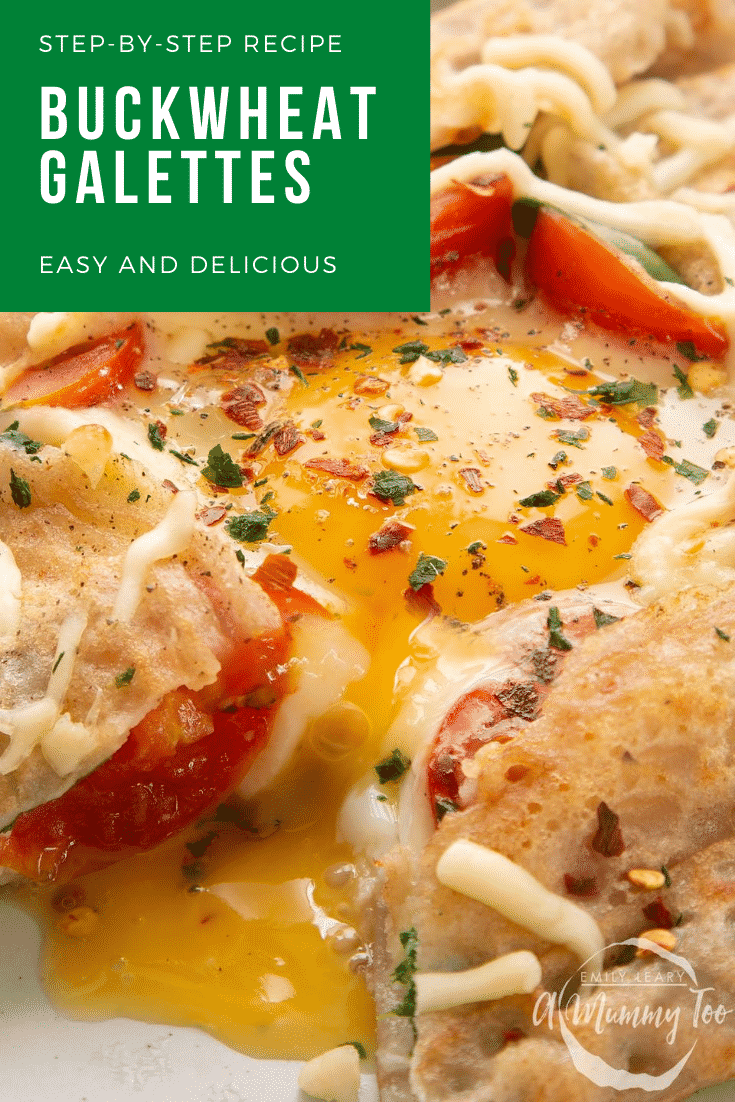
Even if you have an excellent nonstick pan the coatings can degrade over time, so it's important to look after them and use a bit of butter to stop the galettes sticking.
If you can see the galette is starting to catch take it off the heat, the residual heat from the pan might be enough to finish cooking the egg before it's all burnt.
Some pans absorb and retain a lot of heat, so you may find that after your pan reaches temperature, you can turn the burner down and maintain a good heat.
If burning is a regular problem, try using a lower heat than recommended. If you have a gas hob, a heat diffuser can be a really helpful tool to stop the pan from getting too hot or heating unevenly.
Why did my galettes turn out wet in the middle?
If the crepes were wet, it may be that you added too much batter to the pan. You want to add just enough to allow you to swirl a thin coating to the edges of the pan.
Too much batter and it won't cook properly. We're aiming for light thin crepes, not thick American pancakes. You can use a ladle to help regulate the amount of batter you use each time.
Before you start adding the toppings, you need to give the galette time in the pan on its own to set. You'll be able to see when the galette is ready for the fillings as the top will go from a wet batter to looking dry all over, and it will just be starting to peel away from the edge of the pan.
If you're worried the crepes will burn, turn the heat down to give the fillings a chance to cook. If you have a lid for your frying pan, you can put it on top for a minute or two, to help cook the egg quicker.
How can I add/change the flavours in my galettes?
The simplest way to tweak this yummy buckwheat galette recipe is to switch an ingredient or two. For example, you could use a blue cheese instead of mozzarella, or swap the chilli flakes for some fresh rosemary.
You can also change the veg fillings, of course - the possibilities and combinations are virtually endless! Have a look in the fridge and cupboards and see what you can come up with. The only rule is that whatever you add needs to be able to warm through in the time it takes for the crepe to reach mottled golden.
You could go very French and try cheese and ham with some spinach. Or sweet with chocolate spread and banana. Frozen fruits can be made into a quick compote before being added to the galette, and served with yoghurt.
Baked apple or pear and goats cheese is a lovely combination. Or how about a spoonful of baked beans and egg?
The humble galette is also a great way to use up leftovers like sausage, bacon, or roast veg. Chop the sausage and bacon into bite-size pieces and warm through in a separate pan before adding to the galettes with an egg.

What is the origin of this recipe?
Galette is a French culinary term loosely used to describe any flat free-form pastries or cakes.
Here we have used buckwheat flour to make our crepe-based galettes, so they would be more accurately called "Breton galettes". Breton galettes originated in Brittany (of course!) and are usually larger than the ones featured hear, often served on large dinner plates.
Breton galettes are traditionally savoury but I think they are just as yummy with sweet toppings too. In fact, we had both sweet and savoury Breton galettes on our last trip to Brittany and they were divine!
Print the recipe for buckwheat galettes
Buckwheat Galettes Recipe
Ingredients
For the galette batter
- 250 g (8.8 oz) buckwheat flour
- pinch salt
- 500 ml (1.1 pint) water
To fry
- 2 tbsp salted butter
To fill
- 500 g (1.1 lb) grated/shredded mozzarella
- 200 g (7.1 oz) fresh cherry tomatoes halved
- 50 g (1.8 oz) fresh spinach
- 8 medium free-range eggs
- 1 tbsp chilli flakes
- Pinch salt and black pepper
To garnish
- 5 g (0.2 oz) parsley finely chopped
Instructions
Make the galette batter
- Put the flour and salt in a bowl.
- Whisk together, then pour in 250ml water.
- Mix into a thick paste, cover and refrigerate overnight to allow the flavours to develop.
- When you're ready to make your galettes, add 250ml water.
- Gently mix until you have a batter the consistency of double cream
Fry the galettes
- Warm a little butter in a large frying pan over a medium heat.
- When the pan has come up to heat, ladle in a small amount of batter and tip the pan to evenly distribute a thin layer of batter. (Note: the water can separate from the flour a little if the batter is left to sit, so gently stir the batter before each ladleful of galette.)
Fill the galettes
- As soon as the batter has set, scatter on a small handful cheese.
- Add a few cherry tomato halves.
- Add a handful spinach, arranged in a circle - this will help contain your egg.
- Crack an egg into the centre.
- Allow the galette to cook until the underside is golden and mottled and the egg is almost set.
- Use a spatula to fold the edges in towards the middle, to create a square with the yolk exposed in the centre.
- Continue to cook until the egg white is set. Sprinkle with a pinch of chilli flakes, salt and pepper.
- Scatter on a little extra cheese. It will melt from the heat of the galette.
Garnish the galettes
- Use a spatula to transfer the galette to a plate. Scatter with a little parsley.
- Repeat until all of your galettes are cooked.
Video
Notes
Nutrition
Pin these buckwheat galettes
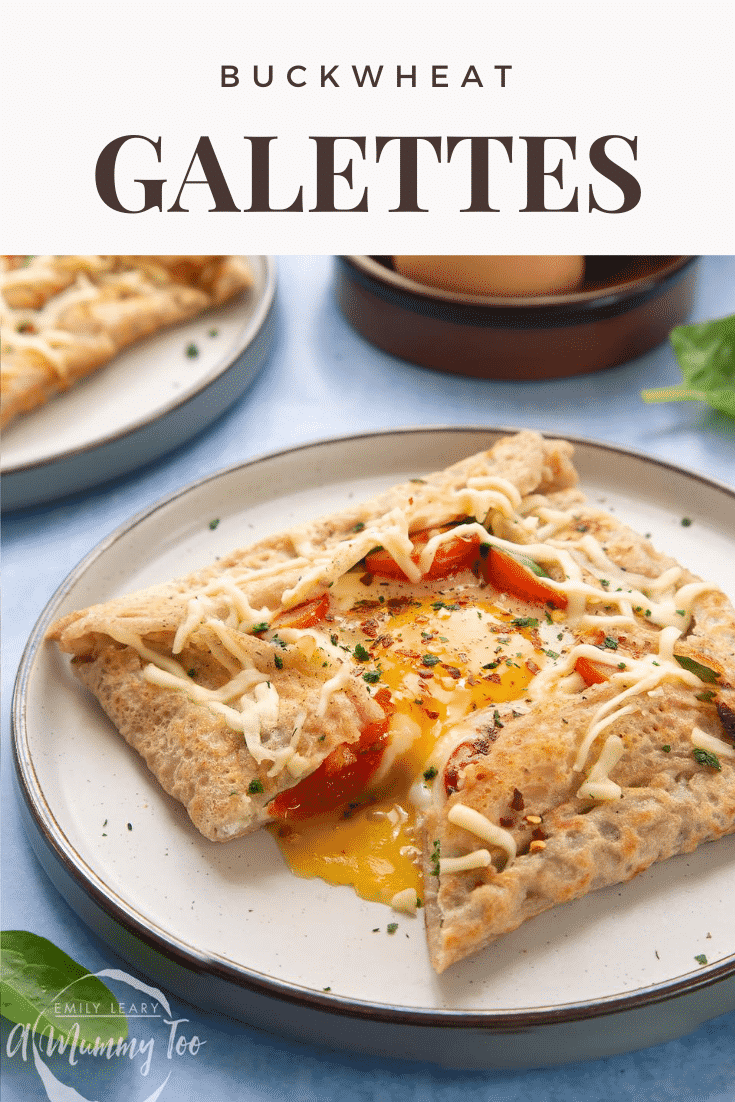

More egg recipes to try
Have you got my book?

'This is a great kids cookery book. Emily is a star' - Simon Rimmer
'The book I'd like to force into any mother's kitchen' - Prue Leith
"A fab book with a plan." - Jane Devonshire, 2016 Masterchef UK winner
'Emily has managed to combine her mummy knowledge and passion for food to make a truly helpful and brilliant cookbook' - Priya Tew, RD, BSc (Hons), Msc
Get Your Kids to Eat Anything is an achievable 'how to' for parents in the battle to overcome picky eating and 'make new the norm'. Emily Leary's unique 5-phase programme looks at the issue of 'fussy eating' in a holistic way that links imagination with food, and which situates parents alongside - not in opposition to - their children.





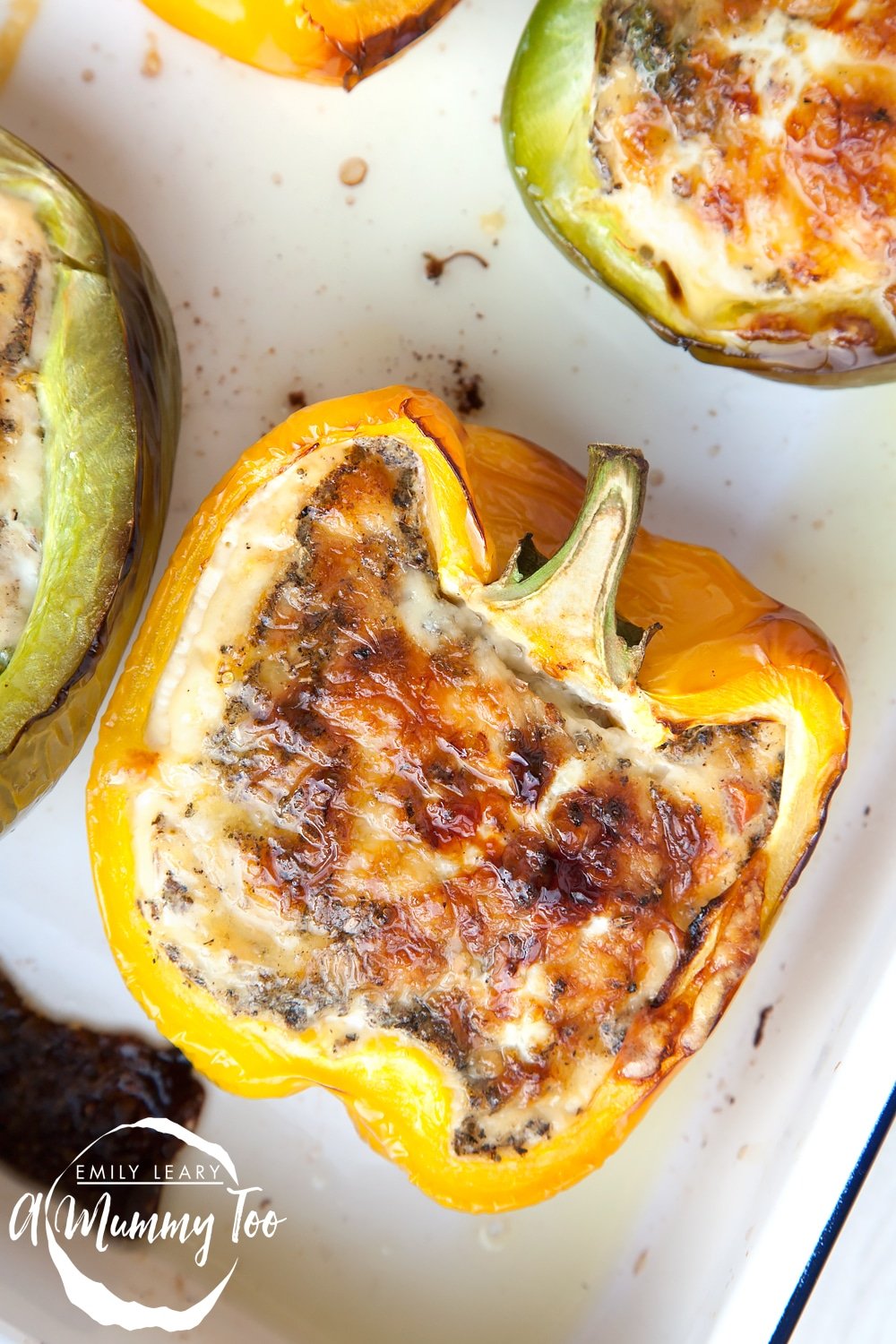

Leave a Reply